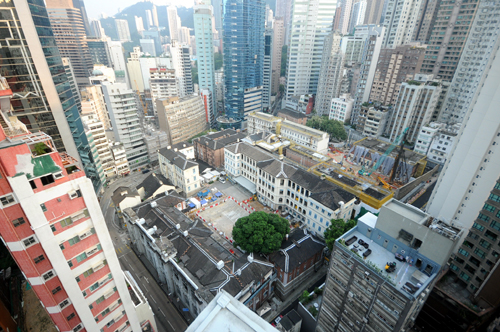In Hong Kong’s cramped space, historic buildings have been vulnerable in the face of profits offered by high land prices, so its physical memory has been almost completely erased. While a new heritage consciousness has taken hold, the lack of a comprehensive policy framework usually leaves the government holding the conservation bill, with mixed results. Raymond Wong reports.
The traces of Hong Kong’s built heritage are rich and diverse, reflecting the many influences on this remarkable entrepôt: colonial rule, obviously, but also the emergence of powerful Chinese clan families, maritime defense before and after the British, evolving economic activities, public health, education, China’s revolutionary movements, war, and recovery from war.
Even the Japanese occupation left much of this historic fabric intact. But this changed after the 1960s when Hong Kong experienced its first exponential economic take-off. Now these traces are very faint. In such limited space, historic buildings got in the way of huge profits offered by high land prices. The area once known as Victoria City was worst hit, with the physical memory of its past being almost completely erased.
Heritage consciousness in Hong Kong has been weak, and just as weak are laws to protect historic buildings. The Antiquities and Monuments Ordinance, enacted in 1976, established one or two statutory authorities to advise government. There is also the Commissioner for Heritage Office, which promotes initiatives and acts as a point of contact. But under this benign policy umbrella owners have been able to use their properties as they see fit.

The old Central Police Station and Victoria Prison Compound hold out among Hong Kong’s towers
This is changing. In recent years the appreciation of heritage has increased, and some owners have shown a willingness to relinquish some control in order to preserve and revitalize historic buildings. But with the lack of a comprehensive policy framework, the government has ended up bearing the cost of heritage projects, which means many don’t happen.
Where government is the owner, progress has been made. In 2007 the office of the Commissioner for Heritage launched a new scheme to preserve and revitalise government-owned heritage properties, and four projects have been completed since 2010.
A good example is the North Kowloon Magistracy, a seven-storey former magistrate’s court designed by Palmer & Turner Architects and built with granite blocks in 1960. It served as the main site for handling offenses in Kowloon until it was closed in 2005 with the consolidation of magistracies.
To give a new lease of life for the building, the government called for international tenders by non-profit-making organisations. Bidders needed to show how their proposed social enterprise would work financially and benefit the community.
The Savannah College of Art and Design (SCAD) won the competition in 2009. Renovation started immediately. The conversion houses 40 classrooms, 16 faculty and staff offices, a library, art gallery, and two computer labs. Many of the original features, including prisoners’ cells, have been retained. The two original court rooms are now a digital studio and a lecture hall.
Where the owner of a property is not government – and property ownership in Hong Kong is as diverse as its historical influences – progress has been more difficult. A good example is the King Yin Lei mansion, built in 1937 by the wealthy Chinese Shum family.
The building changed hands over the years and, in 2004, the present owner notified the government that it planned to redevelop the property by demolishing the building and replacing it with a new one. But the owner also indicated a willingness to negotiate on a deal to save the building, which had appeared in films and marked the rising status of the Chinese community in the 1930s. The government did not take any action. Naturally, it was concerned that if the property was protected from demolition, thus stopping any further development of the site, it would be liable for compensation.
A heritage advocacy group, the Conservancy Association of Hong Kong, wrote to the Secretary for Home Affairs asking it to declare the property a monument under the Antiquities and Monuments Ordinance. The Association also organised a “Save King Yin Lei Campaign”. The owners delayed development and indicated again their readiness to negotiate.
After more than two years the owners activated their redevelopment program and in late 2007 started demolition. When it was reported by the media, the government acted, declaring the site a proposed monument and ordering a work stoppage.
In January 2008, the government reached a preliminary deal with the owner. The owner would surrender the entire site of King Yin Lei to the government and, subject to the necessary town






